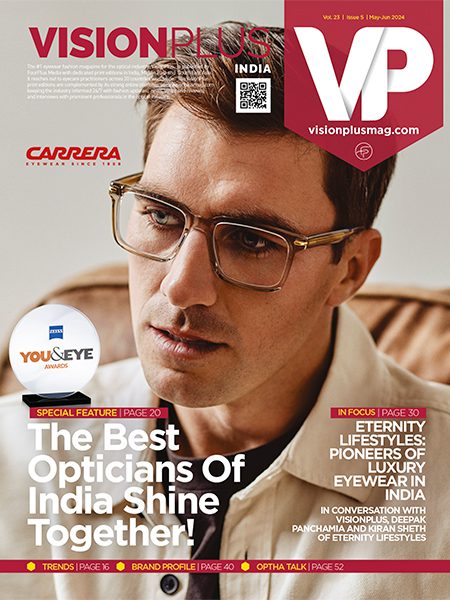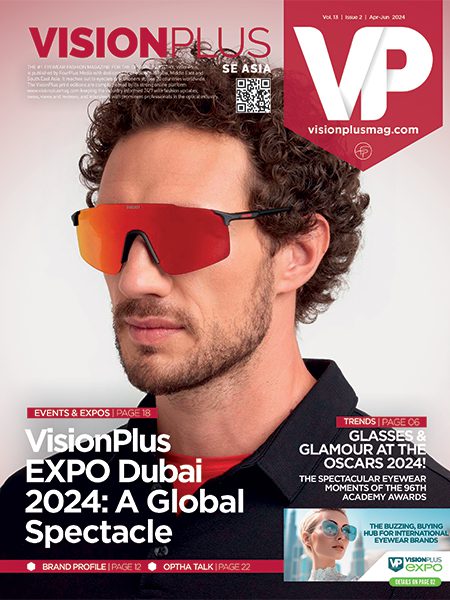

Knowing Your Lenses: Part 1
Pratik Bhatt of Zylux Lenses updates us in this 2 part series about the different aspects of lenses that affect its clarity and its thickness i.e Index and Materials.
This topic is a very vast one and to try and put into just 2 articles could be a challenge but I’ll try to summarise it, the best I can. However before we delve into the details of the index and materials, it’s very important that we discuss a little about Refractive Index and Abbe Value.
What Is ‘Refractive Index’?
Eyeglass lenses are often categorized by their refractive index (also called the index of refraction).
The refractive index of any substance is the speed of light in that substance compared to the speed of light in a vacuum expressed as a ratio. Light travels fastest in a vacuum and slower through different materials.
Refractive Index = speed of light in a vacuum/speed of light in the comparative material the refractive index of a basic plastic lens (CR-39) is 1.498 meaning that light travels 1.498 times faster in a vacuum than it does through the plastic lens.
The higher the index of refraction the thinner a lens can be to get the same refraction effect. Optical lenses are now classified into the following categories:
- Normal Index: 1.48-1.54
- Mid Index: 1.54-1.64
- High Index: 1.64-1.74
- Ultra High Index: 1.74 and above.
What Is Abbe Value?
Abbe value is a measure of the lens material’s dispersion of light. A lens with a low Abbe value causes a higher dispersion and leads to unwanted chromatic aberration. Chromatic aberration is a distortion of the image due to the inability of the lens to focus all colors onto the same focal point. This leads to the perception of undesirable color fringes when viewing objects for many people.
High index lenses offer a thinner lens but usually have lower abbe values. The Abbe value determines to a large part the optical integrity of the lens. The higher the abbe value the better the optical clarity and less distortion. It is a delicate balance to find a lens that not only satisfies in terms of aesthetics and weight but also features acceptable optical clarity.
The chart below highlights the Abbe Value of each index along with its density
Note: All Figures are approximate figures under specified test methods & are not guaranteed as specification
Standard Index
Lenses having an index of refraction between 1.48 and 1.54 are normally classified as Standard or Regular Index. Individuals with a lower prescription may opt for a 1.5 standard index lens. This type of lens is suitable for prescriptions with an SPH correction of +/- 2.25 and less, or a CYL correction of +/- 1.50 and less.
Mid Index Lenses
Mid index lenses have a higher index of refraction (1.56) than CR-39 plastic (1.498) and are therefore thinner in an equal lens prescription. With a higher index (of refraction), light is bent more efficiently, therefore it requires less material to achieve the eyeglass prescription making the lenses much lighter. Another significant advantage of these lenses is that they are impact resistant. It's important to recognize that being impact resistant does not mean shatterproof. They can still break, therefore official safety glasses should be worn for eye-hazardous jobs and sports. Additionally, they can also block UV Rays up to UV385 Nanometers and above.

Hi Index & Ultra Hi Index Lenses
An even higher index lens should be considered to achieve the thinnest lenses possible. This means the index of refraction would need to be greater than that of polycarbonate and Trivex (>1.60). High index lenses are classified by numbers that represent their refractive index and range from 1.61 to 1.74. High index lenses can be up to 50% thinner than regular glass or plastic lenses, and they’re usually much lighter, too. Although these lenses are generally recommended for people with high optical prescriptions, high index lenses can benefit anyone who would like a thinner lens profile. The higher the index, the thinner the lens will be relative to basic plastic. One of the biggest disadvantages of high index materials is the higher cost compared to other materials including polycarbonate and Trivex. High index plastics also have a lower abbe value (32-42) and therefore have some problems with chromatic aberrations. Because of the way that light interacts with high index lenses (chromatic aberrations), it's highly recommended that an anti-reflective (AR) coating also be applied to the lens to help with reflected light.
High index plastics do offer good ultraviolet inhibition (below 380-400 nanometers) properties as well as shatter resistance.
A lens with a higher index of refraction tends to reflect light more than standard CR-39 plastic or glass lenses. The extra reflections are usually quite bothersome for the wearer especially at night and while using a computer monitor. The glare from the lenses is also cosmetically unappealing. Because of this most high index lenses come with an anti-reflective coating as a standard option. In the next article, we will explore the different types of lens materials ie Glass, Cr-39, Polycarbonate and Trivex







